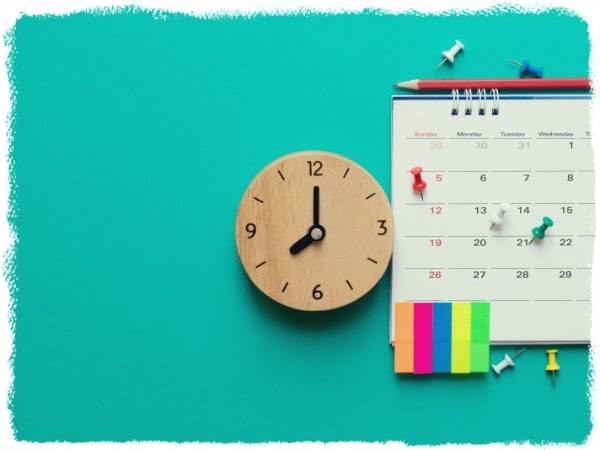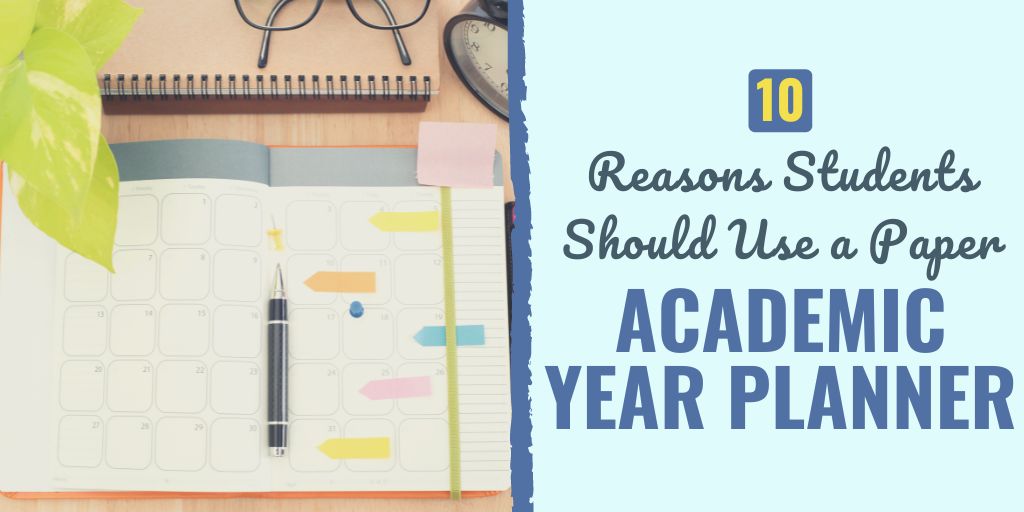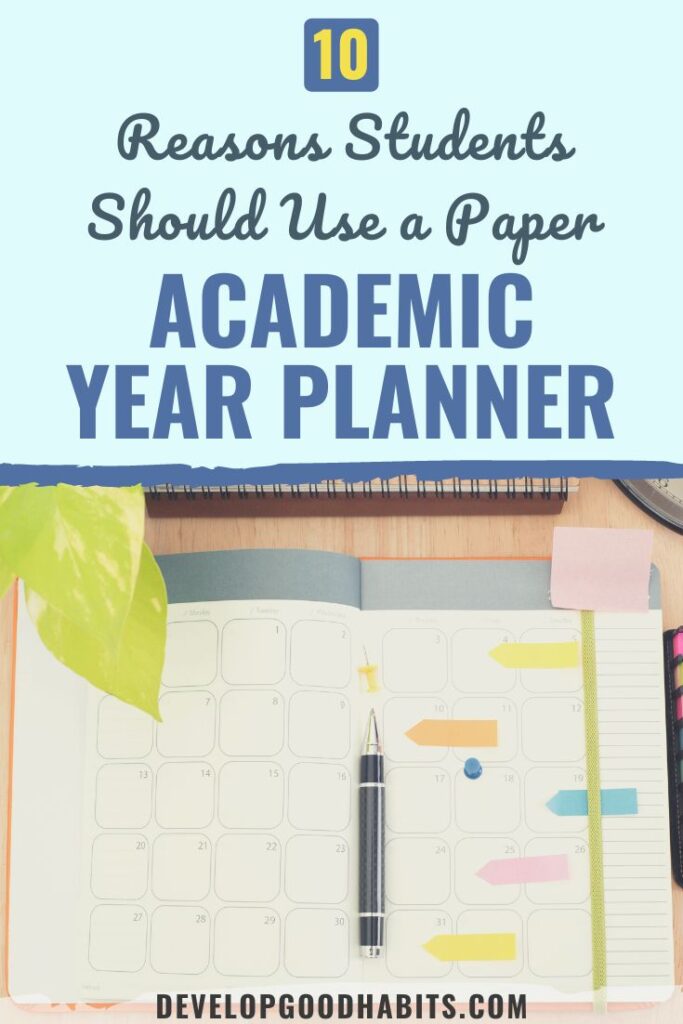There might be affiliate links on this page, which means we get a small commission of anything you buy. As an Amazon Associate we earn from qualifying purchases. Please do your own research before making any online purchase.
A paper planner isn't just a creative or decorative piece of stationery.
Studies show that students who use a paper academic year planner are more prepared and do better in school than those who don't.
And while digital planners are fine to use on a smartphone, tablet or computer, productivity experts say a paper planner is best. Using a paper planner helps students retain information and better schedule their studies, work and commitments.
What is an Academic Year Planner?
An Academic Year Planner is a powerful organizational tool that spans from August or September to the following July, aligning with the academic year. This format aligns with school schedules, making it ideal for students, teachers, and educational professionals.
One of the key features of an Academic Year Planner is its specialized layout. It typically includes dedicated sections for each month, with ample space for daily or weekly planning.
Within these sections, you'll find areas to jot down class schedules, assignment due dates, exam periods, and extracurricular commitments.
Using a planner is a keystone habit that will lead to the development of many good practices, such as becoming more productive and reducing stress.
Here is our list of 10 reasons why students should consider using a paper academic year planner for success in the classroom.
1. Teachers recommend using paper academic year planners.
The statistics linking classroom success and planner use are not just made up by planner and stationery companies.
Experts in learning, productivity and academics all agree that using a planner helps students. Some say it could be the most critical study aide you can invest in to ensure your child performs well in school.
Chances are your student's teacher also agrees. Many university professors and counselors recommend keeping a planner. Unlike high school, professors do not care if you turn in your work, so encourage them to write down every due date.
In a University of Kentucky study by Sung Hee Kim, students who committed to a microaction of using a planner reported “positive changes in their lives. The study participants achieved a greater sense of being organized, less stressed, better time management and, best of all, improved academic performance.”
Kim notes that almost all participants selected paper planners over digital planners, despite the full availability of smartphone apps for planning and studying.
The study suggests that students realized the advantage of using paper planners, including the psychological benefits of writing things down.
2. Writing by hand improves understanding.
Keeping any planner – paper or digital – is a step in the right direction. However, just like with note-taking in the classroom, writing by hand generally improves the understanding of the material.
It's theorized that the ability to remember material increases in a paper planner since writing it down involves deeper cognitive processing of the content than typing it.
Many students find success using both methods, coordinating appointments with your iPhone or laptop but planning your days, and using reminders on paper.
Simply by proactively planning their day helps students develop good study habits. But nothing can replace the victorious feeling of physically crossing something off of your paper planner!
In terms of paper planners, there are a variety of planners to choose from:
Weekly Planners are also sometimes called life planners and contain monthly spreads in addition to a weekly layout for each week of the year. It allows students to track both long and short term goals.
Often sections are provided for checklists, habit trackers, bullet journaling, note-taking and more.
Student Planners are specifically designed for the needs of the student. Frequently weekly spreads are broken into columns or rows based on subjects or activities (or both).
The best student planners allow for customization of inside pages so that column labels are preprinted and the student won't have to rewrite them each week. Student planners also often come with student-specific checklists, worksheets and communication planners.
Daily Planners are often used if students like to plan on a more micro level. With one or two pages dedicated to each day, a student can become very granular in their planning.
Hourly Planners can be either weekly or daily but give segmented and labeled sections for each full, half or quarter-hour. It allows a student to plan his or her day in great detail. It is often favored by college students to manage their time in the best possible way.
Traveler's Notebooks are becoming increasingly more popular and have the advantage of being refillable. It is merely a leather or leather-like cover that holds multiple notebooks with elastic bands.
Notebooks are available with calendars, checklists, dot grid, blank pages and more. Each notebook combines to be an organization and productivity system. The benefit of the Traveler's Notebook is it isn't static and can change and improve over time.
Bullet Journals were created by Ryder Carroll to help others live a more productive life. The bullet journal is a streamlined system that includes sections to log daily to-do lists, calendars, notes and long-term goals.
It often uses grid or dot grid paper and entries are generally tagged with bullet points or graphics, so categories are seen at a glance. Artists and creative types often use bullet journals and use their artistic abilities to enhance their pages with calligraphy and hand-drawn illustrations.
3. Improve your time management skills.
Planning in a paper planner teaches time management better than most other activities.
You can plan your day in as little as 15-minute increments. It lets you time box things for activities such as email, study breaks and activities. It also ensures a student is dedicating enough time to study all their subjects, including the ones they don't like.
Another benefit to using a planner for time management is that it is easy to color-code tasks and categories of activities. Many student productivity experts suggest using color coding. It makes it easy to find related items that need to be done to accomplish a particular goal or objective.
Color coding is accomplished by using highlighters, markers or stickers to indicate categories. Popular school color coding includes:
- Colors for each subject
- Colors for the type of assessment (assignments, homework, exams, presentations)
- Colors for deadlines/due dates
- Colors for types of activities (school, work, extracurricular)

4. Track activities and extracurricular commitments.
As we mentioned above, careful planning of your days allows you to dedicate time to the things you like and are more social and not feel guilty.
These activities themselves come with deadlines and schedules and the more aware you are of them, the better you can schedule school and study-related items around them.
Activities, clubs and sports are essential for high schoolers looking to attend prominent universities. They also take up a considerable amount of time. To juggle school work with these activities, a planner is essential to make sure nothing gets missed or neglected.
5. Stay on top of assignment due dates.
Taking a planner to class with you ensures that you are recording immediately all due dates assigned by the teacher or professor.
During the first week of school, many students receive a syllabus for their classes. This is the perfect time to transfer all those deadlines in your planner so that you can plan for them accordingly.
You can also record resources, contact information and grading standards so that it's in one place for easy reference! And, keep your planner handy every day to write down assignments and additional due dates that come up.
After writing down due dates, have your student ask themselves, “How do I achieve this goal?” Whether it's a test or a project, a student can break it down into steps so they'll be ready to succeed.
This type of “work back” schedule gives them more goals to record in their planner, so they have a daily roadmap to follow without agonizing over it last minute.
For example, if there's an exam on November 5th, what needs to be done to receive a good grade? It might mean reviewing concepts of each unit every week, working through practice problems and studying vocabulary. Based on these tasks, it could mean accomplishing each one weekly.
Based on activities already in the planner, the student knows they have band practice on Tuesdays and Thursdays. So, Mondays from 5 to 7 p.m. are dedicated to unit reviews, Wednesdays from 5 to 7 p.m. are for practice problems, and after class on Fridays from 2 to 3 p.m., they review vocabulary.
While older students can quickly and easily isolate and record what needs to be done to be ready for an exam or project, younger students might need help.
As a parent, asking questions about what would help the student is a helpful way to start the conversation and to get the student to break down steps themselves.
6. Manage tasks and accomplish your goals.
Most classes have some project or goal to work towards by the end of the term. A planner is a great way to keep track of your progress toward any goal.
Many planners have goal tracking pages where you can regularly record your progress after you break the project down into manageable tasks.
And planners aren't just for academic goals. Many people keep track of health and nutrition goals by using goal trackers in their planners. These habit trackers can remind them to drink eight glasses of water or exercise each day but can also record money saved, meditation, sleep and more.
Keeping track of progress helps motivate students to stick with goals to become a habit that lasts. After they accomplish several days of completing a habit, they won't want to break their “streak.”
Habit trackers can be created on a blank, lined or grid pages or by using decorative pre-designed pages or stickers. How you structure a habit tracker depends a lot on personal preference.
A landscape page orientation helps with multiple habits on one page or a habit that has a longer duration. A habit tracker spread across two pages is ideal if you're using a small notebook and want to keep everything horizontal.

Planner stickers come in various shapes, colors and sizes. A daily or weekly habit sticker can be used in margins, sidebars, or even in daily or weekly calendar boxes.
Some of the most popular habit trackers in planners include:
- Water consumption
- Vegetable & fruit consumption
- Reading log
- Homework
- Spelling practice
- Exam study
- SAT prep
- Flashcards
- Formula revisions
- Exercise
- Sleep
- No spending
- Gratitude log
- Bible readings or study
Students can set these up by themselves or parents can encourage their students to develop certain habits and help them identify short-term goals. They can also help by providing rewards for accomplished goals that will serve as motivation for continued success.
7. Better organization contributes to improved sleep.
Consistently getting quality sleep improves a student's mental emotional and physical performance. It also enhances their immune system, balances hormones, boosts metabolism and improves brain function.
The more organized you are, the better you will sleep. Simply planning out your next day in an academic year planner will alleviate stress allowing you to put your mind at ease and fall and stay asleep.
The CDC analyzed data from a 2015 study to determine how much sleep students got on school nights. About 6 out of 10 (57.8%) of middle schoolers did not get enough sleep on school nights, and 7 out of 10 (72.7%) of high schoolers were lacking sleep on school nights.
According to the National Sleep Foundation, sleep can help you eat better and manage the stress of simply being a teen. They suggest keeping a diary or to-do list to jot notes down before you go to sleep.
That way, a student will be less likely to stay awake worrying or stressing. There's no better place to do this than in a paper planner.
Another suggestion from the National Sleep Foundation is to make sleep a priority. Try creating a sleep diary that tracks student's sleep allowing them to see habits that are helping or hurting their sleep.
This information – ranging from naps and medication taken to exercise and caffeinated drinks – could easily be tracked inside a student's planner. It would also then be convenient to share with physicians or professionals when treating other illness.
If you want to know how to wake up at 5 am, without an alarm, and not feel tired, take a few minutes to watch the video below.
8. Reduce stress by staying organized.
Students of all ages – elementary, middle school, high school and college – are more stressed than ever. Anxiety and depression for kids aged 5 to 25 have hit a record high and more and more are being hospitalized for mental health issues.
Experts recommend breathing exercises, positive self-talk, healthy nutrition, sleep and exercise to cope with stress issues in the short term. In the meantime, they can work to resolve underlying concerns in the long term.
A recent survey conducted by the American College Health Association found 25.9% and 31.9% of college students reported anxiety and stress over the past twelve months. Approximately 16.9% reported experiencing depression.
Managing stress is a learned skill and planning your day, your year and your life can help keep stress minimized. Paper planners become vital to creating habits that prevent stress from occurring.
By utilizing checklists, calendars and trackers, students are aware of the activities that need to be completed before anxiety overtakes them.
Here are some signs to look for that your student might have stress or anxiety:
- Panicked
- Difficulty sleeping or sleeping too much
- Moody or withdrawn
- Breathing faster
- Feeling nauseous
- Tearful
- Headache
Seeking professional help combined with setting your child up to succeed with time management techniques is key to gaining control. A side benefit of planning is the growing number of groups who socialize and develop bonds around planning.

Many planner-related social media groups, conferences, parties and meetups now exist for sharing ideas, promoting different planner types and accessories. Participation in these types of activities helps their members stay motivated and share success stories for developing healthy habits.
9. Be prepared for contact with teachers or professors.
Especially as students get older, having meaningful conversations with teachers and professors is essential. Students must be prepared before the meeting occurs to take advantage of their instructor's precious time.
A paper planner provides space to jot down questions and concerns to address with teachers as they come up. Rather than waiting until minutes before the meeting to decide what to say, keeping a list of talking points in your planner will help you direct the conversation.
Having a carefully planned and organized meeting with the teacher shows that the student has organizational skills and allows them to help students better.
10. Schedule time for fun.
We've all heard the “work hard, play hard” saying. Well, planning helps that become a reality.
By planning out the work that needs to be done, students will feel like they've earned a much-needed break to kick back or have some fun. Plus they'll know when they can spend time just having some fun without it impacting their school work or other commitments.
Simply playing or having fun has its own benefits. It can reduce stress, stimulate the mind and boost creativity. These are all things that are important for a student to be ready to learn.
By scheduling time for fun in a planner, a student lays a great foundation for the learning process. It's also an excellent reward for trying your best and living life to its full potential.
Final Thoughts on Academic Year Planners
There’s no doubt using an academic year planner is an easy way for students to achieve success in the classroom.
Remember, it's not just about planning; it's about unlocking a pathway to better time management, reduced stress, and a more organized, balanced life. By choosing a paper planner, you're not just adopting a tool; you're making a deliberate choice to enhance your academic journey.
From staying on top of assignments to managing your goals and fostering better communication with your educators, a paper planner can be your ally in the quest for academic excellence.
Hopefully, these ten tips will help every type of student from elementary to college and beyond and set them up for productive habits as they enter the workforce and manage their budgets at home.
And if you're looking for more tips on how to improve your school life, be sure to read these articles:
- 15 SMART Goal Examples for College Students
- 17 Educational Goals Examples & Ideas for Students
- 11 Vision Board Ideas and Examples for Students
Mimi Robinson is a self-described planner enthusiast, Mimi has been both a writer and organizer, streamlining homes, projects and the lives of clients and family for more than 20 years. She lives outside of Seattle with her husband, twin daughters and Shih Tzus named Pippa and Lulu.


